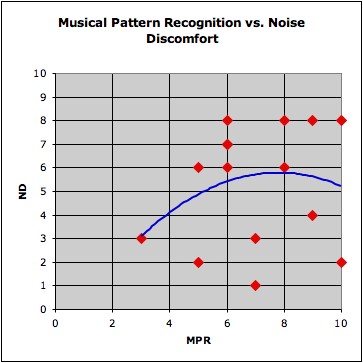NOTE: This is an audience participation post. See the bottom for how you can help!
The other afternoon, I was listening to WNYC’s Radio Lab, a show from a New York public radio station. Radio Lab always has really interesting shows, where they take a topic and run with it wherever the curiosity of the inquisitive hosts leads. The topic du jour was Musical Intelligence, and the major chapters of the program included tonal language as it relates to perfect pitch, our tendency to use baby talk as a surrogate and supplement for touch, and a music composition program that uses human composers’ scores as input.
(Interesting fact: people who grow up speaking tonal languages, such at Mandarin or Vietnamese where the pitch at which one speaks a work alters its meaning, have a 75% incidence of perfect pitch, whereas the rest of the world has 10% or less.)
One of the topics the show discussed was how the brain deals with unfamiliar sounds. Since our gray matter likes nothing better than recognizing and ordering patterns, there’s a dedicated group of neurons that spring into action whenever a new sound intrudes upon your ears. These neurons try to process and catalog the incoming noises. If they fail, they dump out some dopamine, a neurotransmitter that can affect one’s mood.
Now, I have a rather curious quirk: I hate being in noisy places. Being in a restaurant with lots of people and hard surfaces becomes almost physically uncomfortable for me after a mere 5 minutes or so. But playing in or listening to a loud band doesn’t bother me in the same way — my problem seems to be mostly with unstructured sound.
When I heard about this pattern-recognition center in the brain, it occurred to me that perhaps the reason for my aversion to noise is that my brain is unusually aggressive in its attempts to recognize patterns, and when it can’t do so, gets fatigued quickly. This theory would seem to be supported by the fact that I have good relative pitch, and can transcribe a melody I’ve heard more easily than most people. (This, by the way, is my sole gift as a musician, and is the reason I tend to like learning new instruments more than mastering old ones.)
So, to help me corroborate my theory, I need your help! I’d like to find out how people’s skill at recognizing musical patterns correlates to their level of discomfort with noise. If you could help by rating yourself on a scale of 1 to 10 in each of those areas, I’ll compile the results and see if there’s any statistically significant correlation between the two numbers.
To help out, here’s what the scales will be:
- Musical Pattern Recognition: 1 (tone deaf) – 5 (can usually hum back a melody after hearing it a couple of times) – 10 (can unerringly write down or play a melody after hearing it once)
- Noise Discomfort: 1 (fine working in a noisy factory) – 5 (happy at a cocktail party) – 10 (don’t like to go public places without earplugs)
So, for my own assessment, I’d give myself an MPR of 8 and a ND of 8 as well.
So, if you’re willing to help, leave a comment with your rating of yourself in these areas! I’d love to have ratings both from other people who are musical and who aren’t so that I can have data on both sides of the equation. Thanks in advance for your contributions, gentle readers!
UPDATE: Early results are coming in. There’s a definite clustering at one corner of the graph. Come on, non-musical and/or noise-loving people, we need to hear from you!
UPDATE 2: More data, and a trend line on the graph now. There is a bit of a trend emerging, though Barry skewed the far end, which may put the lie to my theory. We need some non-musical people to help fill in the gaps for us!
UPDATE 3: You guys rock. Thanks for all the good data. I’ve plotted the additional information, and the correlation I expected look less and less strong. It is interesting that there seems to be an inverse bell distribution on the noise tolerance taken by itself — people seem inclined to be either bothered not much or a fair bit by it. I’ll keep gathering data for a week to gather any stragglers and then post final results.

